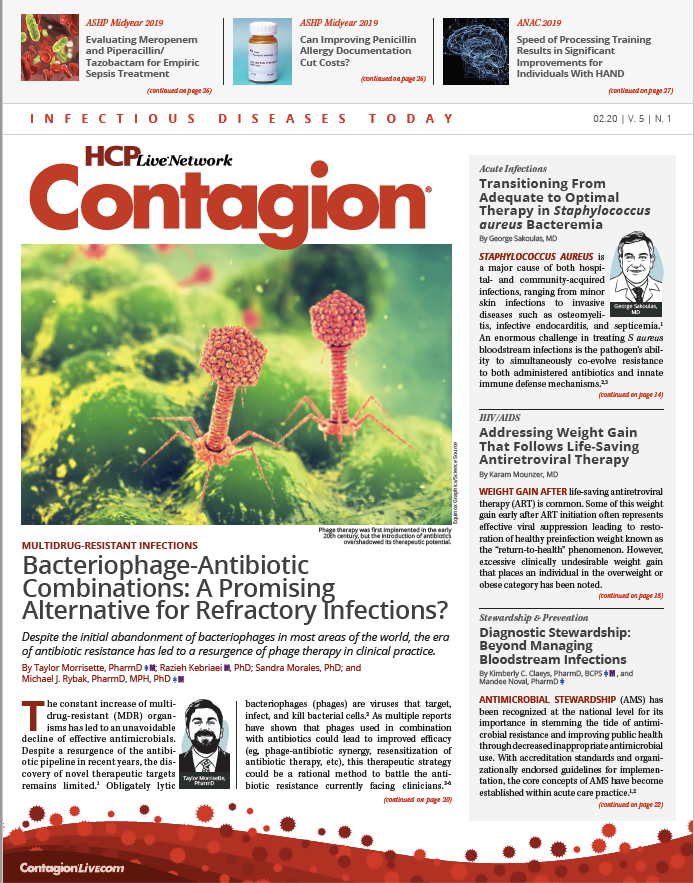IDWeek 2019 News Network: Assessing Challenges to Treating CABP
Thomas Lodise, PharmD, PhD, provides an overview of options for treating community-acquired bacterial pneumonia and highlights the challenges of the infection.
Segment Description: Thomas Lodise, PharmD, PhD, professor, Albany College of Pharmacy, provides an overview of options for treating community-acquired bacterial pneumonia and highlights challenges of the infection.
Interview transcript: (modified slightly for readability)
I think in the general community, there's a sense that we have a large number of agents for the treatment of patients would see CABP. But if you look at the guidelines, what we really see is a limited number of drug classes. Largely we're left with the use of a β-lactam and for our inpatients in combination with a macrolide. There are the respiratory fluoroquinolones—and most of us are aware of many of the increased box warnings associated with them. Doxycycline, which is a drug that is considered in the guidelines, but has limited evidence for use in CABP, and our 2 newer agents omadacycline and lefamulin.
When we look at the guidelines, we see there's a lot of different treatment options and some variations but most of those are variations within a drug class. Clearly, we can use broader spectrum agents, vancomycin, linezolid, even our antipseudomonal β-lactams. However, good stewardship practices tell us that this should be avoided, particularly among patients with CABP. I think we do have agents, but I think they're limited, and I think lefamulin and omadacycline are 2 welcome additions to our armamentarium for the treatment of adult patients with CABP.
I think first and foremost, it's a disease state we treat empirically. You know, as indicated by the guidelines, collection of sputum and other respiratory samples are no longer recommended, and blood samples should only be collected individuals who are at high risk for septic shock.
There are really 2 consequences to this. First, you don't always know exactly what you're treating. I think we have a good sense of our CABP pathogens, and again, it's still Streptococcus pneumoniae, Haemophilus influenzae, Moraxella, and some of our atypicals, however, we don't know exactly what we're treating.
The consequence of that is we use initial broad-spectrum antibiotics and we really have limited opportunities to deescalate, if we knew what the pathogen was. I think the other biggest thing with CABP is we have a limited number of agents. So again, we have a lot of agents, a lot of different β-lactams, macrolides, fluoroquinolones, to choose from; however, there's some class effect. For example, if someone's allergic to penicillin, you can’t use ampicillin-sulbactam, amoxicillin; and you may or may not be using some of the cephalosporin antibiotics. If someone has an allergy to a fluoroquinolone, or they’re in a high-risk group for 1 of its adverse events, this is a class effect.
So I think the second major treatment challenge in patients with CABP is just a limited number of class agents available. Also, as part of that, historically we use a lot of monotherapy with macrolides. Most regions in the United States have greater than 25% resistance. And in that scenario—even a patient without comorbidities—macrolides are no longer recognized, monotherapy agents. I think they have shown some increased survival benefit in some of our sicker CABP patients, but we have lost the macrolides as a monotherapy agent in the outpatient setting in patients without comorbidities.
The third biggest challenge is site of care. I think we have some good triage tools to identify the initial site of care. The one advocated by the latest iteration of the community-acquired pneumonia guidelines is the PSI, also known as the port score, originally developed by Fine, really helps us to assess, based on the psi risk category, the initial site so, PSI 3 is outpatient, 4 and 5 are inpatient, and even the 4s some of those requiring only a short stay.
Clinical judgment always prevails, but what the literature tells us upon closer inspection is that there's considerable variability among institutions in admitting patients with CABP. Part of that is we're probably admitting a lot of patients we do not have to. The reason why I mentioned it is, you know, with the Affordable Care Act, it's the quality/efficiency of health care. And what we find is that the single decision to admit a patient with CABP whether they needed to or not, could be managed in an observation unit for 48 hours, is associated with costs upwards of $10 to $15,000.

